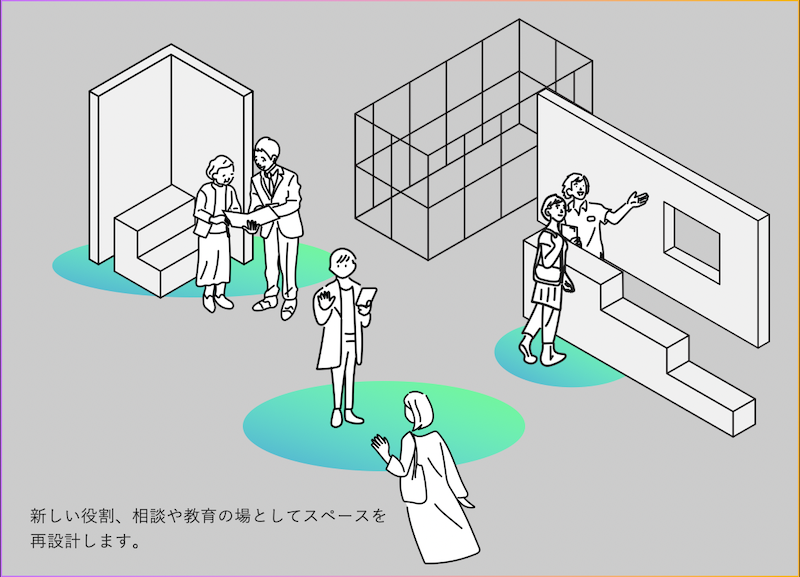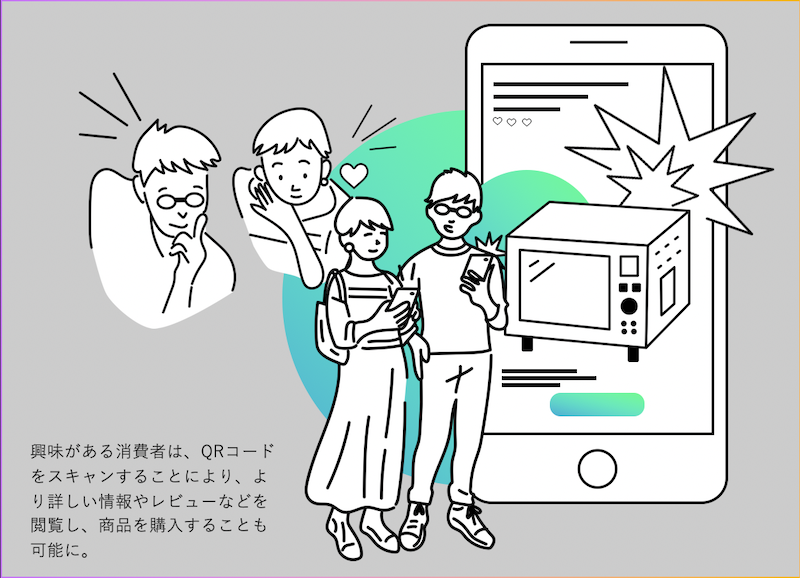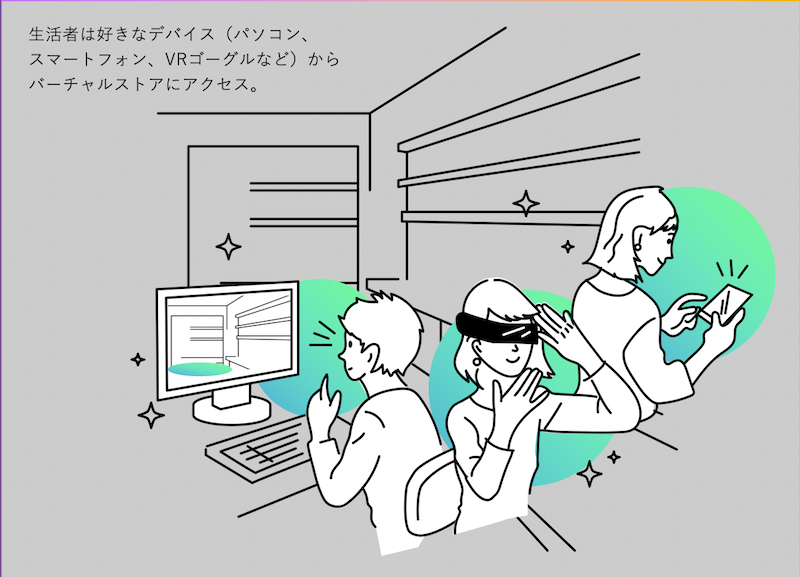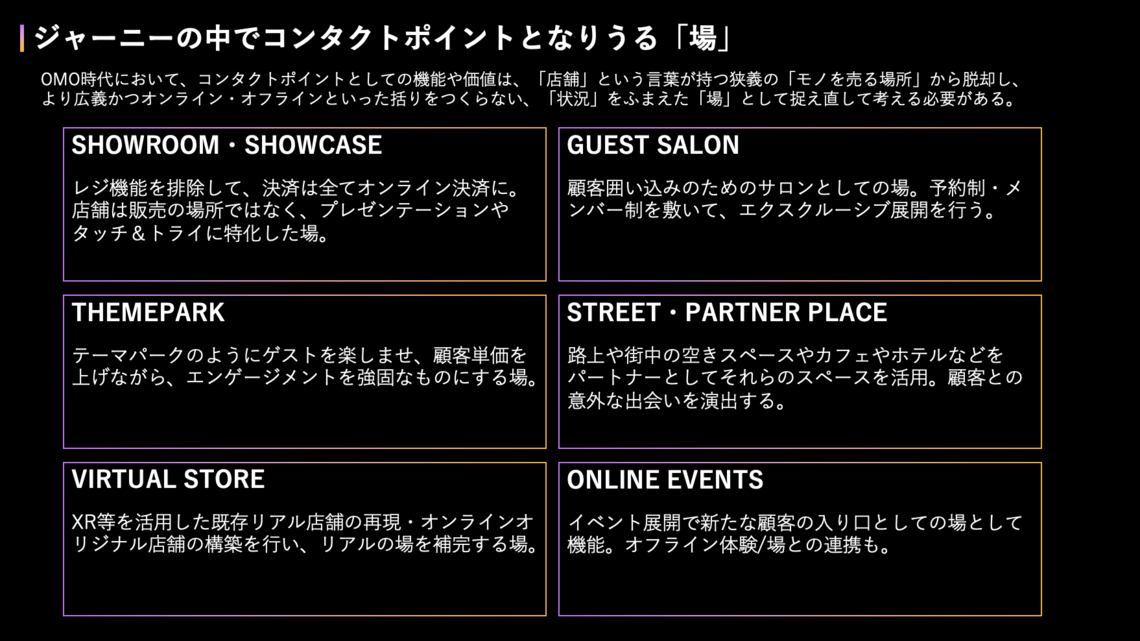As the online shift accelerates across all industries, bringing significant changes to consumers' values and purchasing processes, there is now a demand for new purchasing experiences that seamlessly connect online and offline.
In February 2021, the domestic Dentsu Group launched " dentsu SX" ( *1), a project to design new "shopping experiences" for the OMO (Online Merges with Offline) era. The name SX embodies both "Shopping Transformation" and "Shopping Experience." Through a powerful partnership with frog design inc., one of the world's leading design firms, the project leverages technology and creativity to provide one-stop support—from strategy and implementation to operation—for new shopping experiences tailored to the coming era.
This series examines the changes occurring across five industries—"Cosmetics," "Finance," "Fashion," "Consumer Goods," and "Home Appliances"—and explores future prospects.
In the sixth installment, Mr. Dai Kusakari and Mr. Tatsushi Fujino of Dentsu Live Inc. discuss the changes occurring in the "Home Appliances Industry" and its future outlook.
※1 dentsu SX
A project by seven domestic Dentsu Group companies designed to create integrated online-offline purchasing experiences aligned with the OMO era from the customer's perspective, contributing to business growth in the retail sector. It integrates the Dentsu Group's accumulated business expertise with the insights of its strategic partner, frog design inc. By combining Dentsu Inc.'s proprietary customer behavior data and cutting-edge technologies like AI and cloud computing with creativity that captures customer insights, it creates unique shopping experiences for brands from the customer's perspective. ( See release for details )
Essential post-purchase customer support for enhancing user experience
――Please tell us about the current challenges facing home appliance manufacturers.
Kusakari: The biggest challenge is that "products have become harder to sell." There's the simple decline in demand due to population decrease. While Japanese home appliances traditionally excelled in functionality and technological prowess, recent years have seen a shift toward valuing simple features and price points. Above all, more consumers now seek value in the experience itself. Manufacturers are likely tackling this with a sense of urgency, recognizing the need to break away from traditional sales methods and drive transformation.
Fujino: We're seeing more communication focused on "experience appeal" – conveying "how wonderful life is with this" – rather than just "product appeal" that highlights the brilliance of features and performance. In fact, some brands are actually boosting sales by stripping down features as much as possible and focusing instead on crafting a worldview, design, and user experience.
――So consumer needs have changed, but where exactly do users' pain points lie with home appliances?
Kusakari: With information overload today, consumers need to discern what's truly reliable. Especially with appliances, you often can't grasp their value without experiencing them firsthand. The sheer volume of information—including comparison sites and user reviews—actually makes it harder to filter and decide.
Fujino: Some consumers gather information from EC mall reviews while also visiting manufacturer stores or electronics retailers to talk to staff, or watching appliance-focused YouTubers' videos – seeking information from sources they personally trust. However, the final purchase often happens at a cheaper EC mall, creating a challenge for manufacturers: it becomes difficult to build ongoing relationships with users after the sale.
Kusakari: On the other hand, purchasing through e-commerce malls can sometimes mean inadequate after-sales service. Users face pain points like getting passed around when making inquiries or encountering difficulties getting repairs done smoothly.
Fujino: Currently, most manufacturers focus primarily on electronics retailers and e-commerce malls as their main battlegrounds. However, relying solely on a low-margin, high-volume business model is becoming increasingly difficult. To enhance user loyalty, post-purchase customer support and communication are essential. Therefore, it's necessary to re-examine sales channels and service design.
Methods for Creating Direct Contact Points with Users
――What kind of sales channels and service design are needed to enhance the user experience?
Kusakari: "D2C Inc." (D2C), where companies sell products and services directly to consumers without intermediaries like retailers or distributors, could be an effective strategy. While opinions vary on D2C's benefits, I believe its two major strengths are "direct access to user data" and "the ability to build long-term trust relationships with users."
Fujino: When going through retailers or distributors, user feedback and data often don't reach manufacturers directly. Today, it's crucial to discern needs from user information and incorporate user voices into product development. Systems that don't connect directly with users present a major barrier.
――What benefits does D2C Inc. offer users?
Kusakari: If users and manufacturers can build a solid trust relationship, users can trust the information the manufacturer provides to a certain extent. This eliminates the hassle of filtering through other sources of information, which is a clear benefit. Additionally, receiving comprehensive customer service also contributes to a sense of security.
Fujino: Considering this, it's practically difficult to limit sales channels solely to company-owned stores or the company's own e-commerce site. Therefore, it's crucial to create a system that provides post-purchase contact points and customer service even for users who buy our products at electronics retailers or e-commerce malls.
Kusakari: At the electronics manufacturer I was seconded to, we didn't stop at getting users to make a purchase. We explored what the post-purchase journey should look like, focusing on how to maintain ongoing communication with users, and challenged ourselves to develop contact points and services.
One manufacturer is increasing direct contact points by offering after-sales service linked to their app and organizing user-participation events at flagship stores. I believe one ideal form is creating "spaces" that enhance user experience value by combining various channels, both online and offline.
Designing seamless experiences within users' daily routines
――What ideas do you have for creating spaces that enhance experiential value?
Kusakari: The most obvious "space" is your own store. But if opening a permanent store is difficult, you can try limited-time pop-up stores as a trial. In the apparel industry, we're seeing more cases where D2C Inc. brands, primarily online, open pop-up stores in Tokyo and generate buzz.
Fujino: For example, with kitchen appliances, you could integrate the "space" into experiences happening in other industries or for different purposes, like cooking classes. While you'd need to carefully design the subsequent customer journey, it's an effective way to create an entry point for people to experience the product.

Example of a "space" solution: Pop-up School
Host curated pop-up events. Consumers can learn about products and services without feeling pressured to buy. Leverage technology to provide personalized recommendations. Access this space via app or website, allowing customers to purchase products online while receiving in-person assistance from staff.
Kusakari: Designing spaces that minimize purchase pressure for users might be key. Utilizing gaps like station or street spaces lowers user barriers and reduces initial costs. One shoe brand created an airport pop-up offering AR try-ons and 3D foot scans, enabling on-site ordering with later delivery.
It's not necessarily about making the purchase happen at that specific "space." The key is designing a seamless experience within users' daily routines, then building the path from that experience to purchase and the subsequent post-purchase customer journey.

Example of a "space" solution: Community Space
Physical stores are renovated and redesigned into experiential spaces focused on building trust with consumers. Using the space for purposes beyond transactions fosters a sense of community and supports online experiences.
Fujino: Beyond physical spaces, creating virtual "places" for experiences online is also possible. Electronics retailers, for instance, have started online customer service to provide experiences similar to in-store interactions, even during prolonged stay-at-home periods due to the pandemic.

Example of a "space" solution: Product Placement IRL
Brands form strategic partnerships with spaces (hotels, coworking spaces, model homes, car dealerships, mobile phone shops, etc.) to display and introduce products in appropriate spaces and moments within consumers' daily lives. This not only increases product awareness but also enables consumers to try products and purchase them on the spot.
Kusakari: It's said that as AR/VR technology, haptic transmission technology, and 5G infrastructure advance, a "mirror world" replicating the real world virtually will become possible. If virtual shopping becomes highly accurate, it could significantly transform the purchasing experience in the home appliance industry, where there remains a certain demand for physically seeing, touching, and confirming products.

Example of a "Space" Solution: Virtual Store
Utilizing 3DCG and photographs to recreate physical stores online. Virtual stores allow for the free design of spaces and experiences without the constraints imposed on physical stores. They can also be deployed as limited-time pop-up stores.
No matter the "space," creating heartfelt experiences that resonate with people is essential.
――It's clear that designing spaces that enhance user experience value is crucial. What contributions does dentsuSX aim to make to the home appliance industry going forward?
Kusakari: I believe our strength lies in the ability to provide end-to-end support across all phases—from strategy to implementation—by forming a team with seven Dentsu Group companies plus the international design consultancy frog design. I also consider our unique ability to offer proposals from a "consumer perspective," cultivated by the Dentsu Group, to be a key differentiator.
Fujino: No matter the "space," people won't engage without an experience that stirs their emotions. At Dentsu Live Inc., we specialize in creating "emotion that resonates with people." We aim to leverage this expertise and know-how to update the home appliance shopping experience.
Kusakari: Beyond strategy and planning, actually creating the "space" is also our area of expertise. We can assist across various scenarios—from new business and product development to existing brand redesigns, D2C Inc. launches, flagship stores, pop-up shops, and virtual stores. We'd love to take on these challenges together.
dentsu SX welcomes inquiries and questions from companies. If you're interested, please contact us via our official website.












